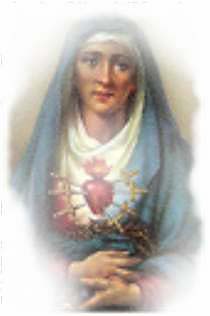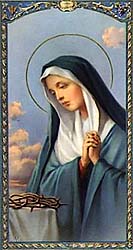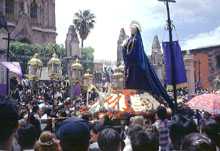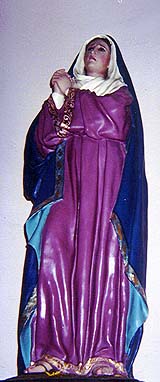 For many years, villages and towns in Mexico, have enacted special Biblical events and gathered to pray at specially erected altars to celebrate sacred figures on each of the Fridays of Lent. These special Lenten traditions, masses and processions remind the people of the lessons and sacrifices of the pre-Easter season.
For many years, villages and towns in Mexico, have enacted special Biblical events and gathered to pray at specially erected altars to celebrate sacred figures on each of the Fridays of Lent. These special Lenten traditions, masses and processions remind the people of the lessons and sacrifices of the pre-Easter season.
Our Lady of Sorrows, Nuestra Señora de los Dolores, is celebrated with processions, masses and altars on the final Friday of Lent, just a week before the Crucifixion of Christ on Viernes Santo. This Feast Day is a prelude to Holy Week, and honors the Mother of Christ in her desolation at the foot of the cross. In early church history this Feast was called The Seven Sorrows of the Blessed Virgin Mary.
Mexico is a land of many Virgins. Many spectators fail to recognize that each of these Virgins is the Virgin Mary, the mother of Jesus Christ as she is venerated in various events and times of her life, (advocacions), or in her many appearances during history (apparitions.)
Our Lady of Sorrows is an advocacion, she is the Virgin Mary, in incredible grief, alone, at the foot of the cross on which her Divine Son is dying . The Feast also commemorates her life of martyrdom, compassion and pain.
Artists paint Our Lady of Sorrows in three traditional poses. In all three, she is dressed in black and deep purple widow’s veils, or in shades of blues and red. Reflected in her face is her despair and tears shimmer on her cheeks.
The most typical of these representations shows Mary standing at the foot of the cross, with her face turned upward. As she views the agony and death of her son, her hands are clasped in an attitude of prayer.
Other artists paint this advocacion with a sword penetrating the Virgin’s heart, portraying the fulfillment of the biblical prophecy of Simeon in Luke 2:34-35. When Joseph and Mary presented her 40 day-old son at the temple, the prophet foretold the role of Jesus bringing resurrection to the children of Israel, adding, “And a sword shall pierce your own soul . . .” The presentation of the infant Christ is still celebrated on February 2, the Day of Candlelaria. The Christ Child figure is raised from the home nativity scene, dressed, and taken to the church to be blessed.
The third view of Our Lady of Dolores shows her with seven daggers in her heart, representing the Seven Sorrows of Mary.
THE SEVEN SORROWS OF THE BLESSED VIRGIN MARY
 The Feast of Our Lady of Sorrows was first celebrated in 1244 A.D. as a devotion and meditation of the seven founders of the Servite Order, to help focus attention on the Seven Sorrows of the Blessed Virgin Mary. The times of deep pain in Mary’s life were:
The Feast of Our Lady of Sorrows was first celebrated in 1244 A.D. as a devotion and meditation of the seven founders of the Servite Order, to help focus attention on the Seven Sorrows of the Blessed Virgin Mary. The times of deep pain in Mary’s life were:
- 1. The prophecy of Simeon at the temple
- Mary was told when her son was 40 days old that he would die attempting to bring redemption to the people of Israel, and that her soul would be pierced by a dagger.
- 2. The flight into Egypt
- To escape the ire of King Herod, and his attempt to kill Jesus by ordering the slaughter of all male children under two years of age, Mary, Joseph and the child fled into Egypt, guided by an Angel.
- 3. The loss of the Child Jesus in the Temple
- When The Holy Family visited the Temple, Jesus disappeared and for three days, while he talked with the elders and priests, his mother could not find him.
- 4. The meeting of Jesus and his Mother on the Way of the Cross
- Mary watched her son struggle to carry the cross to the site of his execution, his face streaked with blood from the crown of thorns, his body cut and bleeding and so weak, he fell under the weight.
- 5. The crucifixion
- Helpless, grieving and alone, Mary stood nearby as her son was nailed to the wood, suffered and died.
- 6. The taking down of the body of Jesus from the cross
- In her pain and sorrow, Mary received the broken body of her son.
- 7. The burial of Jesus
- Hurrying to complete the task before sunset and the beginning of the Sabbath, Mary, with a few friends, tended to the practicalities of the burial of Christ in a borrowed grave.
ALTARS OF COMPASSION AND GRIEF
 On the Friday of the Our Lady of Sorrows, altars are erected in the streets, homes and churches in Mexico, to remember the Virgin, her pain, and her own great sacrifice. The Friday of Sorrows is also an introduction and prelude to Holy Week, Semana Santa, which begins two days later with Palm Sunday.
On the Friday of the Our Lady of Sorrows, altars are erected in the streets, homes and churches in Mexico, to remember the Virgin, her pain, and her own great sacrifice. The Friday of Sorrows is also an introduction and prelude to Holy Week, Semana Santa, which begins two days later with Palm Sunday.
Altars to Our Lady of Sorrows help participants share her pain and grief, and reminds them that she is considered the greatest of all Martyrs. She gladly experienced this lifetime of sorrow so believers could receive her Son’s ultimate gift, the grace of redemption.
The altars are created by placing the image or statue of Our Lady of Sorrows in the center of the selected space, accompanied by a Cross. Around her are arranged large candles in white or purple, decorated in crepe, and as many flowers as the budget will allow. Traditional colors of the flowers vary to include shades of purple, symbolizing grief; all white representing purity; or white and red for the blood shed by Jesus.
Sprouted sage seeds blessed on February 2, have also long been associated with the celebration of Our Lady of Sorrows. Growing greens remind the viewer of the resurrection and renewal of life. These sprouting sage seeds are also known as Ghia, the seeds traditionally sprouted in the grooves of clay animals, figures and pots.
 Some symbolize the bitterness of the suffering of the Virgin by placing bitter oranges on the altar. Sometimes the oranges are painted shiny gold to represent the highest purity of Our Lady. The altars are frequently crowned with cut paper banners, and in some areas, symbolic designs, shapes and forms are formed on the floor with seeds, colored powders and flower petals.
Some symbolize the bitterness of the suffering of the Virgin by placing bitter oranges on the altar. Sometimes the oranges are painted shiny gold to represent the highest purity of Our Lady. The altars are frequently crowned with cut paper banners, and in some areas, symbolic designs, shapes and forms are formed on the floor with seeds, colored powders and flower petals.
As a reminder of Mary’s tears, fruit flavored beverages, agua frescas or water and salt, are offered to each guest at the altar. As family and friends gather to view the altar, the traditional hymn, Stabat Mater, written by Giacopone da Todi in 1306, is often sung. The first and third verses of this ancient hymn are:
At the Cross her station keeping,
Stood the mournful Mother weeping,
Close to Jesus to the last.
Through her heart, His sorrow sharing,
All his bitter anguish bearing,
Lo, the piercing sword has passed!
Is there one who would not weep
“Whelmed in miseries so deep
Christ’s dear Mother lo behold?
Can the human heart refrain
From partaking in the pain,
In that Mother’s pain untold?
Reference Links
- The Seven Dolores of Mary
- Los siete dolores de la Santísima Virgen
- Devotions – https://www.emmerich1.com/Seven_Sorrows_of_Mary.htm
Index Page for Las Virgenes de México

